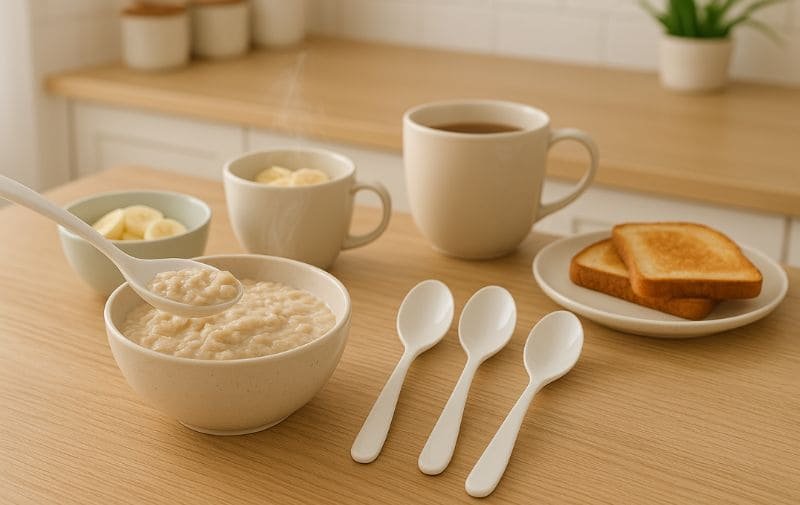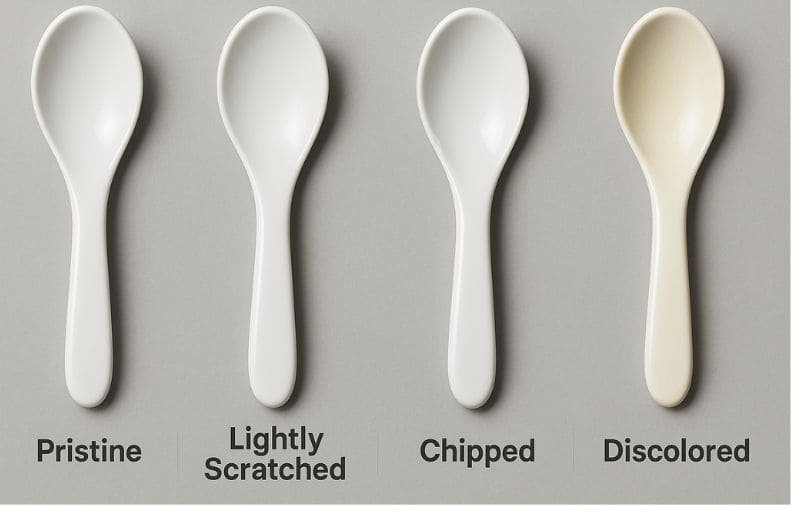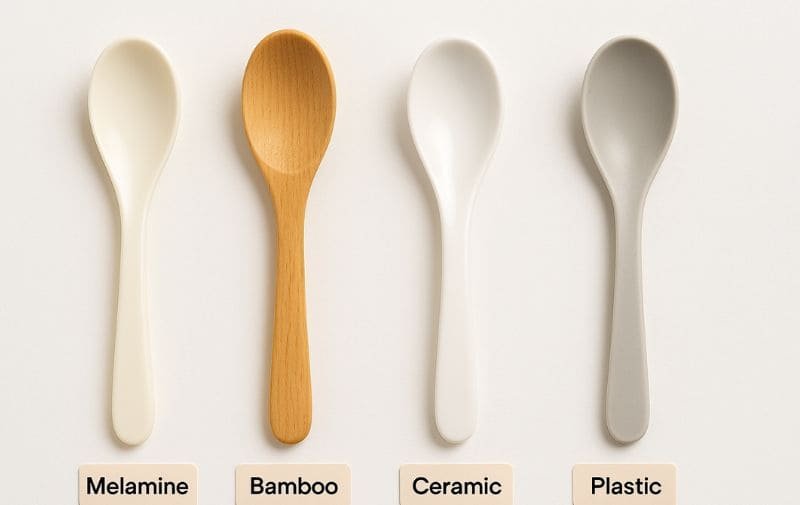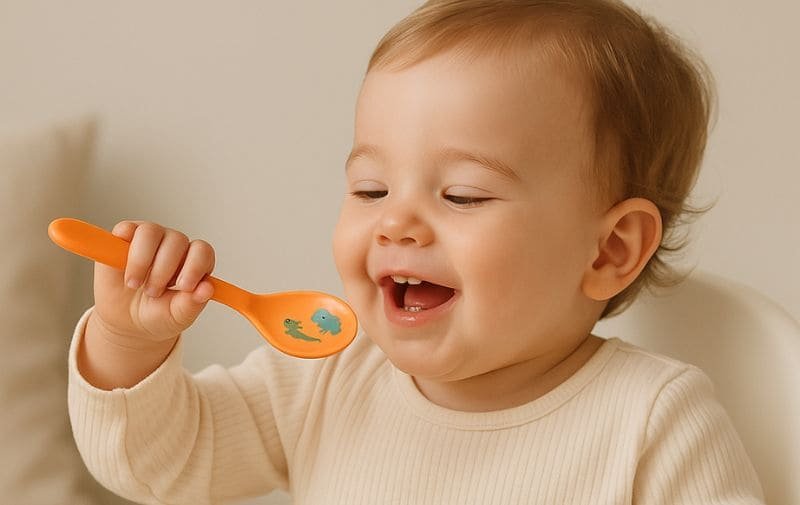If you’ve ever enjoyed a steaming bowl of ramen or pho at an authentic Asian restaurant, you’ve likely used a spoon that felt different—deep, sturdy, and comfortably light. That was almost certainly a melamine spoon. But beyond the noodle shop, these versatile utensils are making their way into professional kitchens, family dining tables, and trendy cafes.
So, what exactly is a melamine spoon? More importantly, is it safe for you and your family to use with hot soup or your morning coffee? Yes, high-quality melamine spoons are safe for everyday use with hot and cold foods. They are made from certified food-grade, BPA-free A5 melamine resin. Their safety depends on using them correctly—they are top-rack dishwasher safe but must never be used in the microwave.
Let’s dive deep into what a melamine spoon, how to use it safely, and why it might just be the most versatile utensil you’re not taking full advantage of.
Last Updated: June 28th. 2025 | Estimated Reading Time: 13 Minutes

What a Melamine Spoon Really Is (Hint: It’s Not Just Plastic)?
It looks like plastic, it feels light like plastic, so it must just be a regular plastic spoon, right?
No, a quality melamine spoon is a thermoset polymer, not a standard thermoplastic. It’s made from rigid, food-grade melamine resin that feels more like ceramic and cannot be remelted, making it fundamentally different and more durable than disposable plastic spoons.
It’s a Thermoset, Not a Thermoplastic
This is the most important distinction to understand. When we think of “plastic,” we usually imagine flimsy, disposable items or flexible food containers. Those are typically thermoplastics, like polypropylene or polystyrene. You can heat them, and they will melt and can be reshaped.
A melamine spoon is in a completely different category. It is a thermoset plastic. During manufacturing, its molecules form strong, cross-linked bonds in a curing process that is irreversible. You cannot melt a melamine spoon—if you expose it to extreme heat (like in a microwave), it will decompose and char, but it won’t turn to liquid.
This thermoset nature is what gives a melamine spoon its signature qualities:
- Ceramic-Like Feel: It’s rigid, solid, and has a satisfying weight that disposable plastic lacks.
- Exceptional Durability: It’s shatter-proof and chip-resistant, making it a reliable choice for busy environments and for use by children.
- Glossy Finish: The high-gloss surface is not a coating; it’s an integral part of the molded spoon, making it non-porous and stain-resistant.
Why 100% A5 Grade Melamine is the Gold Standard?
The key to all of this is the grade of the material. For a spoon to be truly food-safe and durable, it must be made from 100% A5 food-grade melamine resin. This is the standard certified by international bodies like the FDA in the United States and LFGB in Europe. Cheaper, lower-quality spoons might use inferior grades like A1 or A3, which are urea-based and far less stable, but you won’t find those from a reputable manufacturer.
| Material Type | Common Name | Key Characteristic | Behavior Under Heat | Typical Use |
|---|---|---|---|---|
| Thermoplastic | Polypropylene (PP) | Flexible, lightweight | Melts when heated | Reusable food containers |
| Thermoplastic | Polystyrene (PS) | Brittle or foamy | Melts very easily | Disposable cups, cutlery |
| Thermoset | A5 Melamine | Rigid, ceramic-like | Does not melt; will char | Durable dinnerware, spoons |
When buying, if a product isn’t explicitly listed as A5 melamine (or 100% melamine), it’s best to be cautious, especially with suspiciously cheap items.
Are Melamine Spoons Truly Safe for Daily Use?
So, are melamine spoons safe for daily use? Yes, absolutely—provided two conditions are met: it’s made from A5 grade material, and you care for it properly.
Are Melamine Spoons Safe for Hot Soup and Coffee?
This is the most common safety question. High-quality A5 melamine is perfectly safe for hot foods and liquids. It is rated to withstand temperatures from approximately -20°C to 120°C (-4°F to 250°F).
Since boiling water is 100°C (212°F), a melamine spoon is completely safe for serving hot soup, stirring coffee or tea, or scooping up steaming rice. One of its key benefits is that, unlike a metal spoon, the handle remains cool to the touch even when left in a hot bowl.
The Dishwasher Dilemma: Top-Rack Safe, Microwave Forbidden
Dishwasher Safe? Yes. A5 melamine spoons are designed for the rigors of home and commercial dishwashers.
Industry Pro Tip: Always place melamine spoons and other melamine items on the top rack of the dishwasher. The exposed heating element at the bottom of most machines can become intensely hot. While a few cycles won’t cause damage, hundreds of cycles of direct exposure can slowly degrade the spoon’s glossy finish over its long lifespan.
Microwave Safe? Absolutely not. You should never put melamine of any kind in the microwave. It doesn’t melt, but the microwave energy can damage its molecular structure, making it brittle and potentially causing it to break down and leach chemicals.
When to Retire Your Spoon
A melamine spoon isn’t meant to last forever. Its safety lies in its smooth, non-porous surface. You must discard the spoon if you see or feel any of these signs:
- Chips or deep cracks.
- A “chalky” or dull texture, which means the glossy seal is gone.
- Permanent stains that can’t be washed off.

A compromised surface can harbor bacteria and may leach chemicals, so it’s not worth the risk.
| Safety Check | Is it Safe? | Why? |
|---|---|---|
| Serving Hot Soup? | Yes | The material is stable at serving temperatures and insulates heat well. |
| Putting it in the Microwave? | No (Never) | Microwaves damage the material’s structure, causing it to break down. |
| Washing in the Dishwasher? | Yes (Top Rack) | It’s designed to withstand dishwasher temperatures, but the top rack is gentler. |
| Is it Chipped or Chalky? | No | The protective, non-porous surface is compromised. Discard the spoon. |
The True Purpose: The Perfect Tool for Asian Soups
While a melamine spoon is versatile, its design was perfected for one primary purpose: enjoying Asian soups and noodle dishes like ramen, pho, wonton soup, and congee. The design isn’t arbitrary; every feature serves a function.
| Feature | Melamine Soup Spoon | Traditional Western Spoon | The Practical Advantage for You |
|---|---|---|---|
| Shape | Deep, flat-bottomed bowl | Shallow, oval bowl | Holds more broth and solids (noodles, meat, veggies) in a single spoonful. |
| Material | A5 Melamine | Stainless Steel | Doesn’t get hot, won’t scratch your bowl, and makes no harsh scraping sounds. |
| Taste | Chemically inert | Can impart a slight metallic taste | You get the pure, intended flavor of the chef’s broth. |
The melamine soup spoon is engineered to enhance the dining experience, making it easier and more enjoyable to eat complex, layered dishes.
Beyond the Obvious: Unexpected Professional & Home Uses
The same properties that make melamine spoons great for soup also make them a secret weapon for professionals and home cooks.
The Chef’s Secret: A Neutral Tasting Spoon
When chefs taste a delicate sauce or soup, they need to taste the food, not the spoon. Metal spoons can sometimes impart a subtle metallic flavor. Because melamine is chemically inert, it provides a completely neutral canvas, allowing for a truer, more accurate flavor profile.
The Buffet Champion: A Durable Serving Spoon
For caterers and restaurants, melamine serving spoons are a game-changer. They are:
- Lightweight: Easy to handle for hours.
- Unbreakable: No risk of shattering if dropped.
- Scratch-Proof: They won’t damage expensive glass bowls or stainless steel chafing dishes.
- Stylish: Available in a huge range of colors and shapes to match any decor.
The Non-Stick Cookware Protector
At home, a melamine spoon is the perfect utensil for stirring ingredients in your expensive non-stick pots and pans. It’s rigid enough to mix thoroughly but won’t scratch the delicate coating like a metal utensil could.
Why Are They a Top Choice for Children’s First Spoons?
When looking at kids’ cutlery, you see a lot of melamine. Is this just because it’s colorful and unbreakable?
Melamine and bamboo fiber spoons are superior for children due to their safety, ergonomics, and psychology. They are lightweight, have thick handles for small grips, and their warmer, softer feel is less intimidating to a toddler than cold, hard metal.
Choosing the right first spoon for a child is more important than many parents realize. It can make the difference between a frustrating and a successful transition to self-feeding. Melamine and its popular variant, bamboo fiber, are top choices for several key developmental reasons.
Ergonomics for Little Hands
A toddler’s fine motor skills are still developing. They can’t easily manage the long, thin handle of a standard metal spoon. Melamine kids’ spoons are designed with this in mind:
- Thick, Contoured Handles: The handles are typically shorter, thicker, and shaped to fit comfortably in a small, clumsy fist-grip.
- Lightweight: The spoon is light enough that a child can maneuver it easily from the bowl to their mouth without strain.
- Deep Spoon Bowl: The bowl of the spoon is often deeper to help keep more food on the spoon during its wobbly journey.
The Safety & Psychology of Self-Feeding
For a baby or toddler just learning to eat, a spoon is a strange new object. A metal spoon can be intimidating. It’s cold, hard, and makes a loud noise when banged against a high chair tray. A melamine spoon is a friendlier introduction:
- Softer and Warmer: The material feels warmer and softer to the touch, and it’s gentler on sensitive gums and new teeth.
- No Sharp Edges: Quality melamine spoons have smooth, rounded edges, reducing any risk of pokes or scrapes.
- Fun and Engaging: The ability to fuse bright, colorful designs and characters onto the spoons makes them more appealing to children, turning mealtime into a more engaging and positive experience.
The Rise of Bamboo Melamine
In recent years, you’ve likely seen bamboo fiber spoons and tableware sets for kids. This is an excellent evolution of the material. A bamboo fiber spoon is made from the same A5 melamine resin, but it’s mixed with bamboo powder as a filler. This appeals to eco-conscious parents as it uses a renewable resource. The result is a spoon with a unique, often matte texture that is just as safe, durable, and dishwasher-friendly as its 100% melamine counterpart when made to high standards.
| Cutlery Material | Key Advantage | Key Disadvantage | Best for Toddlers? |
|---|---|---|---|
| Stainless Steel | Extremely durable, lasts forever | Cold, hard, can have sharp edges, heavy | Good for older children, less ideal for first-time feeders. |
| 100% Melamine | Lightweight, warm feel, unbreakable, fun designs | Can be damaged by extreme heat/microwaves | Excellent. A top choice for safety and ergonomics. |
| Bamboo Melamine | Same as melamine + eco-friendly appeal | Same as melamine, can be slightly less glossy | Excellent. A stylish and sustainable choice. |
Can Melamine Spoons Be a Branding Tool for Businesses?
Beyond their practical uses, can a simple spoon actually help a business?
Absolutely. Melamine spoons are a powerful and cost-effective branding tool. They can be custom-printed with logos and unique designs, allowing restaurants and retailers to create a cohesive brand experience or sell unique, themed cutlery sets.

In the competitive world of hospitality and retail, every detail matters. A melamine spoon, often sold as part of a fork and spoon set, is a surprisingly effective canvas for branding and creating a memorable customer experience.
How Customization Works
The designs on a melamine spoon are not just painted or printed on the surface where they could wear off. The magic is in the manufacturing process. A custom design is printed onto a special decal paper. This decal is placed in the mold with the melamine powder. Under intense heat and pressure, the decal fuses into the material itself, becoming a permanent, indivisible part of the spoon. This means the design is completely food-safe, dishwasher-safe, and will never peel, fade, or chip.
The B2B Advantage
This customization opens up huge opportunities for businesses:
- Restaurant Branding: A ramen shop that serves its signature dish with a spoon featuring its own logo instantly elevates its brand. It shows an attention to detail that customers notice and transforms a simple utensil into a piece of the brand story.
- Retail Product Lines: Home goods stores and online retailers can design and commission their own unique spoon and fork sets. They can create seasonal patterns, themed collections (e.g., jungle animals, space exploration), or elegant minimalist designs that can’t be found anywhere else, giving them a competitive edge.
- Corporate Gifting & Promotions: A custom-printed melamine spoon set can be a unique and useful promotional item for food-related brands.
Beyond branding, melamine is a smart operational choice. It is significantly more cost-effective than high-end stainless steel but offers a far more premium experience than disposable plastic. Its durability means less frequent replacement, saving businesses money in the long run.
Business Tip: When considering custom cutlery, think beyond just a logo. You can use colors that match your brand identity or patterns that reflect the style of your cuisine to create a fully immersive dining experience.
How Do You Buy High-Quality Melamine Spoons with Confidence?
I’m ready to buy some spoons. What should I look for to make sure I’m getting the good stuff?
For parents, look for spoons clearly labeled “100% A5 Melamine” and “BPA-Free.” For professional buyers, ask suppliers two key questions: “Do you use 100% A5 grade melamine?” and “What are my options for custom printing and flexible MOQs?”
Whether you’re buying a single spoon for your child or a thousand for your restaurant chain, the core principles of quality remain the same. Here’s how to buy with confidence.
For Parents and Home Users:
When you’re shopping in a store or online, you’re looking for signs of quality on the packaging and product itself.
- Check the Label: Look for explicit confirmation that the product is “100% A5 Melamine” or “100% Food-Grade Melamine.” Reputable brands will state this clearly. Also, look for the “BPA-Free” confirmation for peace of mind.
- Inspect the Finish: The spoon should have a perfectly smooth, glossy finish with no bumps, pits, or rough edges.
- Trust Reputable Brands: Choose brands that specialize in dinnerware or children’s products, as they are more likely to adhere to strict safety and quality standards.
For B2B Professional Buyers:
When you’re sourcing for your business, you need to go a level deeper and vet your supplier. A good supplier should be a partner who can provide both quality and flexibility.
- Ask the Critical Quality Question: Your first question to any potential supplier must be, “Do you use 100% A5 grade melamine for your products?” A confident “yes” is non-negotiable. Any hesitation or vague answer is a major red flag.
- Inquire About Customization and Flexibility: A capable supplier should be able to answer your next question: “What are my options for custom printing on spoon and fork sets, and what are your MOQs (Minimum Order Quantities)?” In today’s market, you don’t have to be locked into massive orders. A great partner, like us at Duramela, can offer flexible MOQs to help you test a design or manage inventory effectively.
- Request Samples and Certifications: Before placing a large order, always request samples to inspect the quality firsthand. You should also feel empowered to ask for copies of their food-grade testing certifications (like FDA or LFGB) to verify their claims.

Frequently Asked Questions (FAQ)
1. Can melamine spoons get stained by foods like curry or tomato sauce?
High-quality A5 melamine has a very stain-resistant surface. However, it’s always best practice to rinse or wash the spoon promptly after use with highly pigmented foods to ensure it stays pristine. If a light stain occurs, a paste of baking soda and water can often remove it.
2. Is a melamine spoon better than a silicone spoon for kids?
It depends on the age. For babies just starting solids, a soft silicone spoon is gentler on their gums. Once a toddler is learning to self-feed, a rigid melamine spoon is far better because its stiffness makes it much easier to scoop up food, reducing frustration.
3. How are the patterns on melamine spoons made?
The pattern is printed on a special decal paper with food-safe ink. This decal is placed in the mold with the melamine powder. During the high-heat, high-pressure molding process, the decal fuses permanently into the surface of the spoon, so it can never peel, flake, or wash off.
4. What does “BPA-Free” mean for a melamine spoon?
Bisphenol A (BPA) is an industrial chemical used to make certain plastics, but it is not a component used in the manufacturing of melamine resin. Therefore, all 100% melamine products are inherently BPA-free. The label is often used for marketing reassurance.
Conclusion
A melamine spoon is far from being “just another plastic spoon.” It is a highly engineered, durable, and safe utensil designed for specific purposes. From enhancing the authenticity of an Asian meal to providing a safe and encouraging tool for a child learning to eat, its value is clear.
When you choose a high-quality, A5 grade melamine spoon and care for it properly, you are investing in a long-lasting, practical, and stylish tool that serves its purpose perfectly in homes and professional kitchens around the world.


